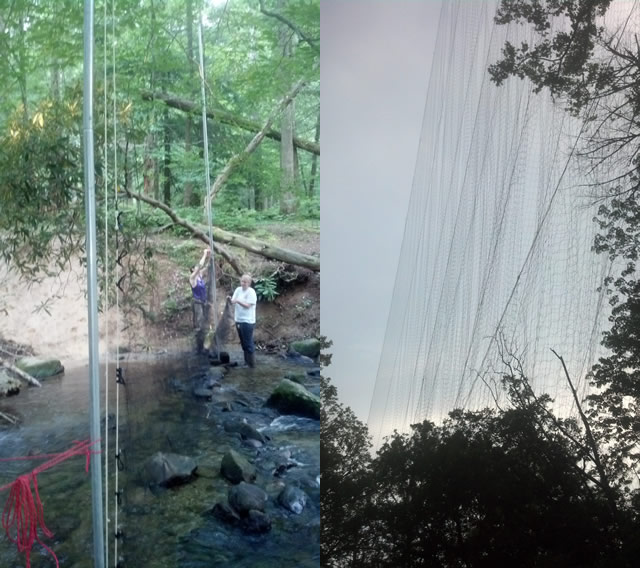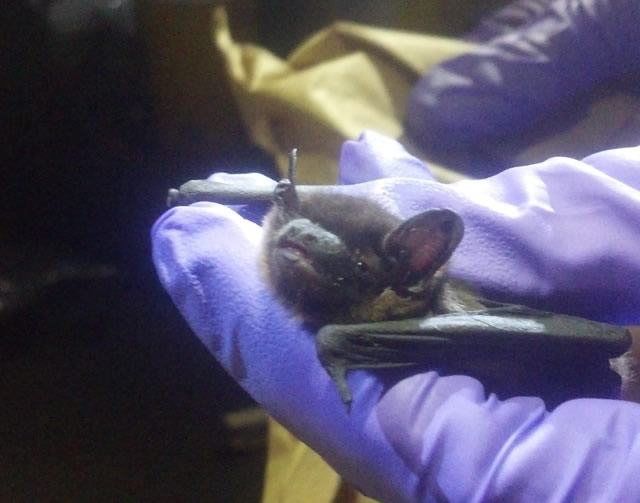Micah Jasny is a graduate student from the Nicholas School of the Environment at Duke University working this summer as an E.O. Wilson Biodiversity Foundation intern, as part of the ATBI/BioBlitz SWAT Team. His work is supported through a partnership with Discover Life in America. This summer he will try to discover new species to add to the park inventories in order to better understand park ecosystems and how to care for them. He also plans to help other scientists working in the park with their biodiversity surveys and scientific research. In the upcoming weeks, he will give weekly updates about his forays into the park and report back on his biodiversity research.
On Tuesday, after finishing up at DLIA, I packed up my dinner and headed back to Cades Cove to go bat hunting. While at Purchase Knob, the other interns and I had run into a bat specialist, who had told us about the plight of bats in the Park and across the nation. Bat populations have been collapsing rapidly due to the fungus, Pseudogymnoascus destructans, which causes white nose syndrome (because the fungus grows on the nose and gives it a white appearance). This fungus was likely transported to the U.S. from Europe. Some species of bats within the park are suffering population declines of 70 to 90%. Cave-dwelling species are especially susceptible since they live in large colonies inside caves, facilitating the transmission of the fungus to other colony members. European bats have been able to adapt to white nose syndrome by living in much smaller colonies, making it harder for the fungus to spread as rapidly as it does in the U.S., yet American bats have yet to show any signs of adaptation.
I was intrigued by this information and the plight of American bat species and decided to go out sampling with Grace Carpenter, a visiting PhD student from the University of Tennessee. Grace has been spending her summer at GSMNP capturing, tagging, and tracking bats within the park to learn more about their nesting behavior and the spread of white nose syndrome. I met up with Grace and her assistant Shelby at Cades Cove and we headed into the picnic area which would be our sampling location that night.
The first step to capturing the bats is setting up the nets. I quickly learned that bat nets are surprisingly complicated and easy to mess up. We began by measuring either 6, 9, or 12 meter distances (depending on the lengths of the nets) and hammering sections of rebar into the soil at each end. The poles for the nets are then assembled and lifted onto the rebar which can be a little tricky as the poles were between 20 and 30 feet in length. Two ropes attached at the tops of each pole are then tied to nearby trees to secure them.


Once all that is done, we could finally put the nets up. Each set of poles had either two or three net sections depending on the height of the poles. Each net had several strings along each of the sides of the net that were tied into rungs on the poles to stretch the nets out. The nets were strung along the poles so they overlapped by a couple of rungs to minimize the possibility of bats escaping through gaps between the nets. Clearly, it’s a complicated apparatus and it is unusual that everything gets setup perfectly on the first try.
We decided to have three sampling sites in the picnic area. The first one was across a stream where bats might sweep low to catch some bugs flying over the water; the second was across a shallow pond were bats might try and take a quick drink; the third was across the road where the trees made a natural corridor that bats might use. It took us about 40 or so minutes to set up the full apparatus. Once that was done, we began checking the nets every 10 minutes starting at nightfall.


If a bat was found stuck in the net, we needed to first try and get it out of the net. This proved slightly difficult as the bat is trying with all its might to fly out of the net, which usually just makes it more wrapped up. The bats are then placed in paper bags to calm them down so measurements can be taken for half an hour. We then weighed the bats and identified their life stage and sex, before analyzing their wings for holes and Pseudogymnoascus destructans fungus. Finally, the bats are then tagged with a little metal transceiver that can be traced the next day to where the bats are sleeping. I was allowed to check the bats for the fungus which meant I swabbed the nose and along the wing of each bat five times with sterile water and placed the swab in a sample tube for later analysis. I also shined a black light on their wings since the white nose fungus fluoresces orange under that light.
Within the first couple of hours we caught four bats. The first two bats were evening bats (Nycticeius humeralis). These bats are pretty small with black fur and a face that kind of resembles that of a bull dog (pictured below). These bats are on the rarer side in the park so it was really impressive that we caught two in one night. The other two bats were red bats (Lasiurus borealis). These bats are larger and covered in a thick red hair. I found out that both of these bat species are tree bats (nest in trees) which explains why they are covered in a thick fur. The fact that these species live in trees means they are less susceptible to white nose syndrome since tree bats do not live in large, tightly clustered, colonies.
After the first couple of hours, we stopped catching bats. We continued to check the nets until about 1:30 in the morning when we stopped and began taking down all of the equipment. Even in the dark, it was a lot easier to take it down than to put it up. Going out to collect bats was a really fantastic opportunity for me. While the information on the drastic collapse in bat populations is readily accessible, it seems to have fallen off of the radar of the general public. Bats are immensely important pollinators and regulators of bug populations. If you like eating fruits and vegetables and hate mosquito bites you need to start learning more about this problem and see what you can do to support your local bats. I know I will.

